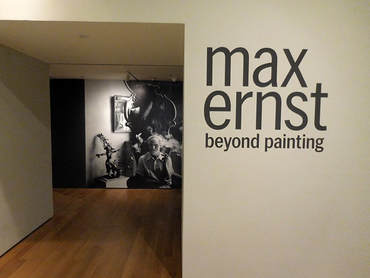 “Max Ernst - Beyond Painting” at New York's Museum of Modern Art is a survey of the career of the Dada and surrealist artist including some 100 works from the Museum's collection. It is called “Beyond Painting” because of its focus on the different techniques that Ernst used in his works. Ernst was born in 1891 outside of Cologne, Germany. By the time the First World War broke out in August 1914, he had already embarked on a career as an artist. Drafted into the German army, Ernst served on both the eastern and western fronts. The war had a traumatic effect on Ernst. Indeed, Ernst wrote that he died on the day the war broke out and was resurrected on the day of the armistice. Returning to Germany, Ernst became interested in the Dada movement. The Dadaists believed that rational thought and bourgeois values had led to the war. Rejecting such thought, they were interested in exploring nonsense, irrationality and the inexplicable. In the 1920s, the Dada movement blended into Surrealism. This movement sought to resolve dreams and reality into a super-reality. It is not surprising that such movements found traction in the post-World War I era. Ernst's generation had just lived through a period where people had lived in mud trenches and at the sound of a whistle, stood up only to be mowed down in the thousands by machine guns and artillery as they tried to cross the lunar-like no man's land. In years of fighting, very little land changed hands. Meanwhile, people were living more or less normal lives a hundred miles from the front. The participants could very easily ask whether reality was rational. Ernst explored these concepts first in Germany and then in France. When World War II began, Ernst experienced more absurdity. He was imprisoned by the French as an undesirable foreigner. Shortly after his friends persuaded the government to release him, the Germans occupied France. Ernst was again arrested, this time by the Gestapo for producing “degenerate art.” Escaping to the United States, Ernst found some financial success and recognition. Nonetheless, he returned to France and continued to live there primarily from the the 1950s until his death in 1976. Many of the Dadaists and Surrealists believed that traditional art embodied the bourgeois values that they rejected. This “anti-art” thinking extended to some extent to technique. Consequently, they looked for non-traditional technique to create art. This exhibition highlights some of the different techniques used by Ernst. To illustrate, in The Gramineous Bicycle Garnished with Bells the Dappled Fire Damps and the Echinoderms Bending the Spine to Look for Caresses Ernst took a chart showing the metamorphosis of brewer's yeast cells, painted over portions of the chart with black paint and then drew in various objects. The result is an image that looks like an abstract circus performance. In To the Rendezvous of Friends (The Friends Become Flowers, Snakes, and Frogs), Ernst made use of grattage. He built up layers of paint and then used hard-edged tools like spatulas and palette knives, to expose the underlying layers of paint and to create surface textures. Ernst used decalcomania to produce the underlayers in Napoleon in the Wildreness. In this process, pigment is applied to a sheet of glass and then pressed onto the canvas. The squeezed pigment makes shapes on the canvas. Ernst then painted figures onto the canvas. There is also a series of sheets in which Ernst used frattage (rubbings) to produce very realistic images. He then added various details to develop the images into something more surreal. Ernst was also a sculptor and the exhibit has several works where Ernst took everyday objects and re-arranged them to create fantastic creatures. Not abandoning traditional technique altogether, the exhibit includes several oil paintings. We see here that Ernst was a very good draftsman. But as in Woman, Old Man, and Flower, the scene has a hallucinatory quality, detailed yet full of the unexpected. Certainly, the spotlight on technique in this exhibit is of interest to people who make art. However, it also provides a view into the creative process that should be of interest to all. |
AuthorRich Wagner is a writer, photographer and artist. Archives
November 2018
Categories
All
|
 RSS Feed
RSS Feed